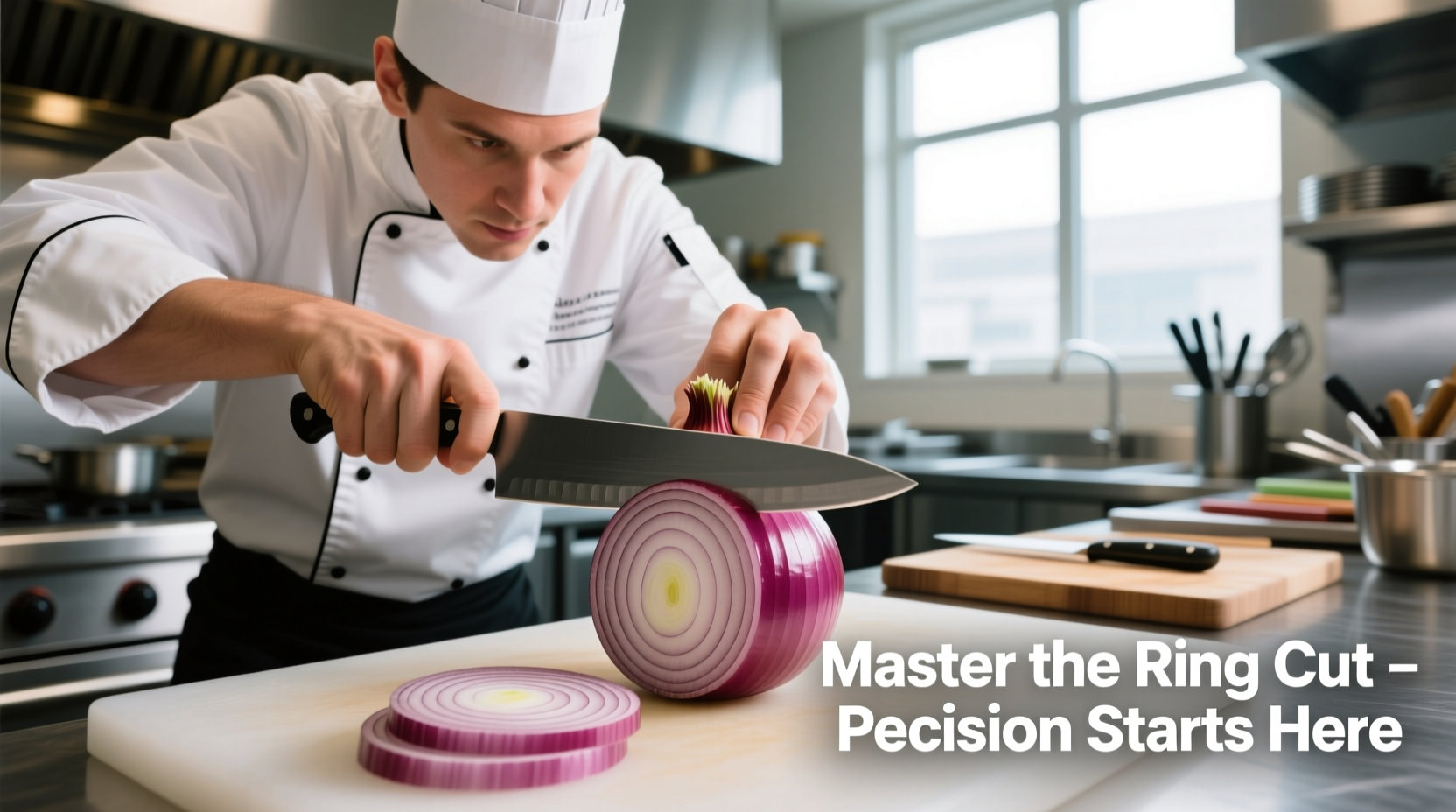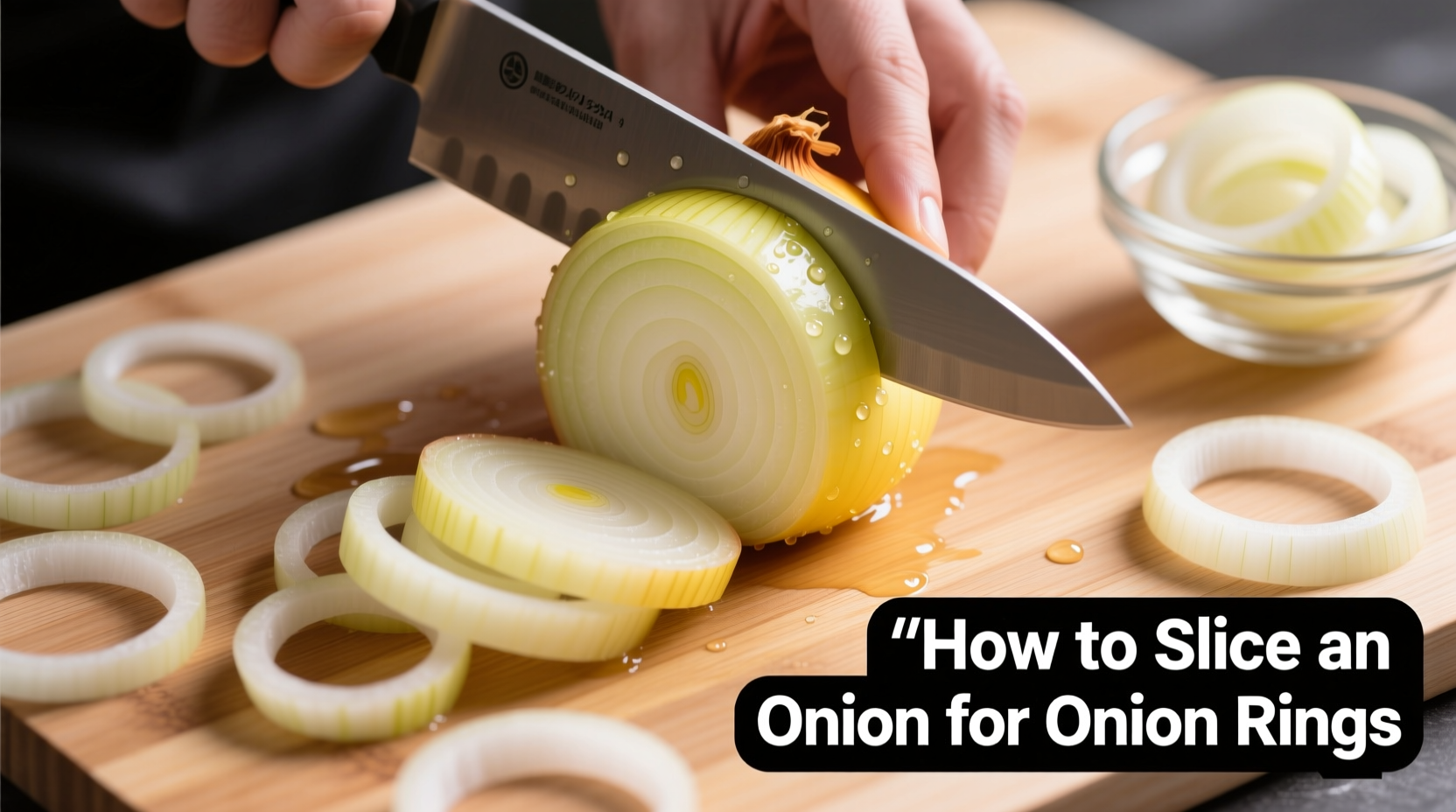Creating restaurant-quality onion rings starts with proper slicing technique. Many home cooks struggle with uneven cuts, broken rings, and excessive tearing, but the solution lies in understanding onion anatomy and applying precise cutting methods. Follow these professional techniques to achieve consistently perfect onion rings that hold their shape during cooking.
Why Proper Onion Slicing Matters for Onion Rings
The difference between soggy, broken onion rings and crisp, golden perfection often comes down to slicing technique. When you cut an onion incorrectly for rings, the layers separate during frying, resulting in uneven cooking and poor texture. Professional chefs know that slicing perpendicular to the root-stem axis while maintaining consistent thickness creates rings that stay intact and cook evenly.
| Onion Type | Best For Onion Rings? | Flavor Profile | Texture When Fried |
|---|---|---|---|
| Vidalia | ✓ Ideal | Sweet, mild | Crisp exterior, tender interior |
| Yellow Storage | ✓ Good | Stronger, balanced sweet-tart | Firm, substantial crunch |
| White | △ Acceptable | Sharp, pungent | Can become tough when fried |
| Red | ✗ Not Recommended | Mildly sweet | Color bleeds, texture inconsistent |
Essential Tools for Perfect Onion Ring Slicing
Before you begin slicing, gather these critical tools that professional kitchens use for consistent results:
- 8-10 inch chef's knife - Must be razor-sharp (dull knives crush onion fibers)
- Stable cutting board - Bamboo or thick plastic with non-slip base
- Vegetable peeler - For removing outer skin without waste
- Measuring guide - Optional but helpful for consistent 1/4-inch thickness
According to the Culinary Institute of America's cooking fundamentals curriculum, proper knife maintenance is essential for vegetable preparation. A sharpened knife requires less pressure, reducing the chance of slipping and creating cleaner cuts through onion layers.
The Step-by-Step Slicing Process
Step 1: Prepare the Onion
Remove the papery outer skin and trim both ends (root and stem), but don't cut deeply into the onion structure. The root end contains fibrous tissue that helps hold rings together - professional chefs leave about 1/8 inch of this intact. This technique, documented in On Food and Cooking by Harold McGee, preserves the onion's natural binding properties.
Step 2: Position for Perfect Rings
This is where most home cooks go wrong. Place the onion on its side (stem-root axis horizontal) rather than upright. The correct positioning ensures your cuts run perpendicular to the onion's growth rings, which is critical for maintaining ring integrity. The USDA's food safety education materials emphasize proper food handling techniques that include stable positioning to prevent knife slips.

Step 3: Execute the Slicing Technique
- Hold the onion firmly with non-dominant hand, curling fingertips inward
- Position knife at 90-degree angle to onion's axis
- Apply steady, even pressure while moving blade toward yourself
- Maintain consistent 1/4-inch thickness throughout
- Rotate onion 180 degrees after first pass to slice opposite side
Food science research from the University of California Davis shows that consistent thickness (between 1/4 and 1/2 inch) creates optimal surface area-to-volume ratio for even browning without sogginess. Thinner slices become overly crisp while thicker ones remain undercooked in the center.
Troubleshooting Common Onion Ring Slicing Problems
Problem: Rings Keep Falling Apart
Solution: You're likely cutting parallel to the growth rings instead of perpendicular. The structural fibers run vertically from root to stem - slicing across these fibers creates stable rings. If rings still separate, leave slightly more root end intact (about 1/4 inch) to maintain structural integrity.
Problem: Uneven Ring Thickness
Solution: Use a guide stick (like a chopstick) alongside your onion to maintain consistent thickness. Professional kitchens often use specialized mandolines with adjustable thickness settings, but these require extreme caution with onions due to their round shape.
Problem: Excessive Tearing While Cutting
Solution: Chill onions for 30 minutes before cutting. Cold temperatures reduce the release of syn-propanethial-S-oxide, the compound that causes eye irritation. The American Chemical Society confirms this method reduces tear production by slowing enzyme activity.
Pro Tips for Restaurant-Quality Onion Rings
After slicing, immediately submerge rings in ice water for 10-15 minutes. This critical step, used by professional kitchens nationwide, firms up the onion structure through osmosis, creating a more stable ring that maintains shape during frying. Don't skip this step - it's the difference between home-style and restaurant-quality results.
For optimal frying results, separate the rings carefully without breaking them. Pat dry thoroughly before dipping in batter - excess moisture creates steam that prevents crispiness. The ideal frying temperature is 375°F (190°C), which creates immediate crust formation that seals the ring structure.
Safety Considerations for Onion Preparation
Knife safety is paramount when working with round, slippery vegetables like onions. Always use the claw grip with your non-dominant hand, keeping fingertips curled under. The National Institute for Occupational Safety and Health (NIOSH) reports that improper grip accounts for 68% of kitchen knife injuries. Never try to catch a falling onion - let it drop and retrieve it safely.
Consider using cut-resistant gloves if you have limited knife experience. While professional chefs often avoid them for better dexterity, they provide valuable protection for home cooks. Remember that sharp knives are actually safer than dull ones, as they require less force and are less likely to slip unexpectedly.











 浙公网安备
33010002000092号
浙公网安备
33010002000092号 浙B2-20120091-4
浙B2-20120091-4